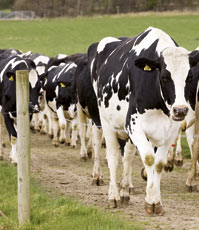Mobility scoring system sees positive results

Almost a year ago DairyCo launched a cattle mobility scoring system with the aim of it becoming the industry standard for measuring lameness in dairy herds.
The system was designed to be simple enough to use on farm, enabling farmers to detect early signs of lameness before developing into serious problems.
The DairyCo mobility score has been a tremendous move to controlling lameness, according to vet Nick Bell, Bristol University.
“Because of its standardised approach to scoring lameness, it has helped clarify the confusion between locomotion scoring used as a breeding tool and mobility score which is used as a tool for managing the cow,” says Dr Bell.
Many producers attending workshops on the scoring system were already scoring their cattle using different systems, comments, Dr Bell.
“As well as getting some great practical tips from those who attended we were impressed at the consistency with which people were spotting lameness within their herds. But, we were looking for a national system to apply on their units,” he says.
There have also been a series of other workshops and training events for producers, consultants and advisers on the practicalities of using the mobility scoring system.
“It’s encouraging to see the high degree of repeatability with the training materials that have been developed to accompany the score and it’s great we are all singing from the same hymn sheet,” says Dr Bell.
There are now a number of research groups across the country using the DairyCo mobility score and putting figures to the economic impact of animals within each score.
“It’s early days yet, but it’s already clear there are better responses to treatment from cows that have recently moved into score two versus cows with chronic lameness being identified for treatment. Also one of the striking things was the number of repeat treatments needed with chronic cases, with some requiring as many as seven repeat treatments.
“It has been a challenge getting people to move from talking about locomotion scoring, which we really feel should only be reserved as a breeding tool,” says Dr Bell. “When it comes to a farmer management tool that can be used to identify cows likely to benefit from treatment, it is much better to talk about mobility scoring,” he says.
“Cows are doing the equivalent of running a marathon a day and they need to be fit on their feet to compete. By using the mobility score we can proactively manage foot health for optimal performance,” he concludes.
Case study
Dairy producer Andrew Mycock, Buxton, Derbyshire, milks 315 high yielding all year-round calving cows. Last November his herdsman, Gregg Bird, attended a DairyCo meeting on mobility scoring at Nottingham University. Subsequently, mobility scoring every month has opened their eyes to the benefits of identifying and treating cases early.
By mobility scoring every month Mr Bird is the one consistently seeing the cows move allowing him to detect small changes. “I’m picking up cows whose mobility has changed from last month’s score before they develop into full blown lameness cases and cost us more money.”
A foot trimmer attends every six weeks looking at all late lactation cows before they are dried off and every cow three to four months after they’ve calved, explains Mr Mycock.
“Prior to Gregg attending the event we would also pick up any obviously lame cows feet in between his visits and we were reasonably on top of our lameness problem. But, since Gregg started monthly mobility scoring the herd, our eyes have been opened to the benefits of identifying cases early.
“Lameness has a knock on effect on milk production and fertility. If the cow can’t walk properly she can’t perform properly. Also we can’t ignore the public perception and concern about lameness within the British dairy herd,” says Mr Mycock.
Mobility scoring is also good for picking up lameness trends within the herd, adds Mr Mycock. “Scoring has highlighted there are more lameness cases in the cows going outside compared to those kept indoors all the time. This can help us target the causes of lameness within the herd,” he says.
Last month 75% of Mr Mycock’s herd scored 0 or 1, but they are working towards over 80% of the herd being in this category.
